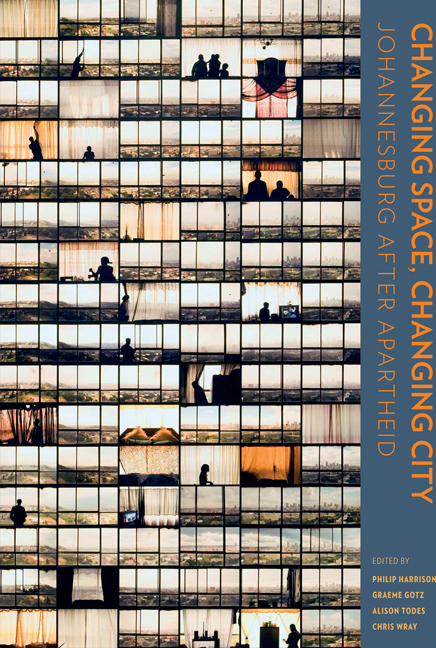Book contents
- Frontmatter
- Contents
- Preface
- Cartography
- 1 Materialities, subjectivities and spatial transformation in Johannesburg
- Section A The macro trends
- Section B Area-based transformations
- Section C Spatial identities
- 23 Footprints of Islam in Johannesburg
- 24 Being an immigrant and facing uncertainty in Johannesburg: The case of Somalis
- 25 On ‘spaces of hope’: Exploring Hillbrow's discursive credoscapes
- 26 The Central Methodist Church
- 27 The Ethiopian Quarter
- 28 Urban collage: Yeoville
- 29 Phantoms of the past, spectres of the present: Chinese space in Johannesburg
- 30 The notice
- 31 Inner-city street traders: Legality and spatial practice
- 32 Waste pickers/informal recyclers
- 33 The fear of others: Responses to crime and urban transformation in Johannesburg
- 34 Black urban, black research: Why understanding space and identity in South Africa still matters
- Contributors
- Photographic credits
- Acronyms
- List of plates
- List of figures
- List of tables
- Index
33 - The fear of others: Responses to crime and urban transformation in Johannesburg
from Section C - Spatial identities
Published online by Cambridge University Press: 20 April 2018
- Frontmatter
- Contents
- Preface
- Cartography
- 1 Materialities, subjectivities and spatial transformation in Johannesburg
- Section A The macro trends
- Section B Area-based transformations
- Section C Spatial identities
- 23 Footprints of Islam in Johannesburg
- 24 Being an immigrant and facing uncertainty in Johannesburg: The case of Somalis
- 25 On ‘spaces of hope’: Exploring Hillbrow's discursive credoscapes
- 26 The Central Methodist Church
- 27 The Ethiopian Quarter
- 28 Urban collage: Yeoville
- 29 Phantoms of the past, spectres of the present: Chinese space in Johannesburg
- 30 The notice
- 31 Inner-city street traders: Legality and spatial practice
- 32 Waste pickers/informal recyclers
- 33 The fear of others: Responses to crime and urban transformation in Johannesburg
- 34 Black urban, black research: Why understanding space and identity in South Africa still matters
- Contributors
- Photographic credits
- Acronyms
- List of plates
- List of figures
- List of tables
- Index
Summary
‘In three hundred metres turn left,’ says the GPS.
‘Temporary road closure’; ‘X Residents Association – Use alternative entrance’; a signboard with an obscure map.
‘Route recalculation …’
And so it went on, road after road closed off to the public, the streets empty apart from a few armed-guard response vehicles, parked menacingly on the verges behind the gates. Two residential areas sandwiched against each other with this thin road acting as some kind of conduit between them, either side of the road enclosed behind retrofitt ed fences. Another 45 minutes of driving in and out of booms, having my details written down by guards, watched cautiously by armed response units and, GPS long since switched off, I finally reach my destination.
In 2002, in my capacity as the editor of a special edition of Urban Forum that was to focus on fear, crime and the city, I presented an overview of crime, theories of its origins and fear of crime in Johannesburg. The article was called ‘Johannesburg: Fearful city?’ Ten years later, there have been changes, notably in the statistical reduction of violent crime; nevertheless, much has remained the same. Urban researchers, however, have a deeper understanding of the urban dynamics associated with fear of crime in South Africa. They have also identified new ways of interrogating these dynamics. Notably, there is an expanding ethnographic understanding of fear in Johannesburg. In this chapter, I update the statistical picture of crime in South Africa. I then review some of the urban features that have arisen in relation to fear of crime and briefly engage with some of the research that has emerged concerning the South African case of fear of crime.
Statistical trends
In 2002, South Africa was rated in a worldwide review of crime statistics as having the highest incidence of violent crime. While statistics are hard to compare across different countries since reporting and information-gathering procedures vary, murder is considered one of the more reliable statistical measures of violent crime, as the definition of murder and the material evidence of murder are not subject to definitional variation (Masuku 2001). South Africa had the highest murder rate worldwide – 59 per 100 000 of the population (Masuku 2001).
- Type
- Chapter
- Information
- Changing Space, Changing CityJohannesburg after apartheid, pp. 546 - 552Publisher: Wits University PressPrint publication year: 2014



